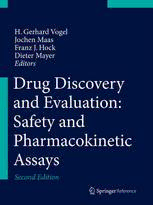
Drug Discovery and Evaluation: Safety and Pharmacokinetic Assays PDF
Preview Drug Discovery and Evaluation: Safety and Pharmacokinetic Assays
H. Gerhard Vogel Jochen Maas Franz J. Hock Dieter Mayer Editors Drug Discovery and Evaluation: Safety and Pharmacokinetic Assays Drug Discovery and Evaluation: Safety and Pharmacokinetic Assays H. Gerhard Vogel (cid:129) Jochen Maas Franz J. Hock (cid:129) Dieter Mayer Editors Drug Discovery and Evaluation: Safety and Pharmacokinetic Assays Second Edition With243Figuresand157Tables Editors H.GerhardVogel Deceased JochenMaas SanofiPharmaDeutschlandGmbH AcompanyoftheSanofi-AventisGroup IndustrieparkHoechst FrankfurtamMain,Germany FranzJ.Hock Dieburg,Germany DieterMayer Idstein,Germany ISBN978-3-642-25239-6 ISBN978-3-642-25240-2(eBook) ISBN978-3-642-25241-9(printandelectronicbundle) DOI10.1007/978-3-642-25240-2 SpringerHeidelbergDordrechtLondonNewYork LibraryofCongressControlNumber:2012954543 #Springer-VerlagBerlinHeidelberg2006,2013 Thisworkissubjecttocopyright.AllrightsarereservedbythePublisher,whetherthewholeorpartofthe materialisconcerned,specificallytherightsoftranslation,reprinting,reuseofillustrations,recitation, broadcasting,reproductiononmicrofilmsorinanyotherphysicalway,andtransmissionorinformation storageandretrieval,electronicadaptation,computersoftware,orbysimilarordissimilarmethodology nowknownorhereafterdeveloped.Exemptedfromthislegalreservationarebriefexcerptsinconnection withreviewsorscholarlyanalysisormaterialsuppliedspecificallyforthepurposeofbeingenteredand executed on a computer system, for exclusive use by the purchaser of the work. Duplication of this publication or parts thereof is permitted only under the provisions of the Copyright Law of the Publisher’s location, in its current version, and permission for use must always be obtained from Springer.PermissionsforusemaybeobtainedthroughRightsLinkattheCopyrightClearanceCenter. ViolationsareliabletoprosecutionundertherespectiveCopyrightLaw. Theuseofgeneraldescriptivenames,registerednames,trademarks,servicemarks,etc.inthispublication doesnotimply,evenintheabsenceofaspecificstatement,thatsuchnamesareexemptfromtherelevant protectivelawsandregulationsandthereforefreeforgeneraluse. Whiletheadviceandinformationinthisbookarebelievedtobetrueandaccurateatthedateofpublication, neithertheauthorsnortheeditorsnorthepublishercanacceptanylegalresponsibilityforanyerrorsor omissionsthatmaybemade.Thepublishermakesnowarranty,expressorimplied,withrespecttothe materialcontainedherein. Printedonacid-freepaper SpringerispartofSpringerScienceþBusinessMedia(www.springer.com) In Memory of Hans Gerhard Vogel 1927–2011 Preface to the Second Edition Both safety and pharmacokinetic aspects are important factors in the Research & Development of pharmaceuticals: safety pharmacology, toxicology and pharmaco- kineticsarethecornerstonedisciplinesofpreclinicaldevelopment,butthescopehas widened both towards Research and towards Development over the last few years. In this book, all in-silico approaches, in-vitro, ex-vivo, in-vivo animal and clinical studieshadtobetakenintoconsideration.Thesestudiesareusedtogeneratealotof data which must be evaluated carefully. It was therefore necessary to include theconductofstudiesbutalsothetechnologiestogeneratethesedatainatextbook like this. Since toxicology and safety pharmacology depend directly on exposure, it was also mandatory to cover PK aspects and technologies. All these aspects were included in the first edition of Drug Discovery and Evaluation: Safety and PharmacokineticAssays. Someofthemethods described inthefirsteditionhavebeenintroducedintothe scientificcommunityovertheyearsanddecades–forinstancespecificchromatog- raphy technologies like gas chromatography – and there were no novel tendencies to be observed between the dates of the first and second editions. These chapters werenotmodifiedsincealltheinformationincludedcanstillberegardedas"stateof theart". Butthereareothertopicswhichhaveshownconsiderabledevelopmentwithmany newinsightsandtechnologies.Transportersandtheirbiologyarethebestexampleof theseareas:thesechaptershavebeencompletelymodifiedsincethefirstedition. A third group of chapters had to consider some new aspects without it being necessary to modify them completely. These were amended by adding new results andexperiences. Andlastbutnotleast,Iwanttothankagainalltheauthorswhocontributeddespite theirverybusydailylivesinthepharmaceuticalsindustry.Andaspecialthankyouto Hans Gerhard Vogel who was the Editor-in-Chief of the first edition and all of the Drug Discovery and Evaluation titles at Springer consisting of Pharmacological Assays,SafetyandPharmacokineticAssaysandMethodsinClinicalPharmacology. Gerhard Vogel passed away in 2011. He initiated the second edition of this title. WithouthimneitherthissecondeditionnoranyoftheothertitlesofDrugDiscovery andEvaluationwouldeverhavebeencompleted. Frankfurt,Germany2013 JochenMaas vii Preface to the First Edition Drugdiscoveryandevaluationhasbeenasequentialprocessforalongperiodoftime. It started with the selection of the most active compound from a series of newly synthesized compounds with the help of special pharmacological assays. Safety aspects were considered by testing the selected compound in high doses in tests directedtoindicationsotherthantheintendedindicationofthenewcompound.These testswerefollowedbypharmacokineticstudies,whichweremainlyaimedatconfir- mation of a suitable half-life time and of oral activity. Safety relied on acute and subacute toxicity studies, which gave information more on organ structure than on organ function.Toxicological and pharmacokinetic studies were adapted to the progress of studies in clinical pharmacology and clinical trials. This strategy has beenchangedduringthelast15yearsforseveralreasons: Some negative effects on organ function, e.g., ventricular tachy-arrhythmia were detectedtoolate.Ontheotherhand,negativefindingsinchronictoxicitystudiesin animalsturnedouttobeirrelevantforhumanbeings. Newscientificapproaches,e.g.combinatorialchemistry,high-throughputscreening, in silico models, pharmaco-genomics and pharmaco-proteomics offered new possibilities. The success rate in the pharmaceuticals industry and the introduction of new chemicalentitiestothemarketperyeardroppeddramatically,whereasthedevelop- menttimefornewcompoundsincreased,sometimesexceedingthepatentprotection. Thisforcedachangeofstrategy: • Parallelinsteadofsequentialinvolvementofthevariousdisciplines. • Theterm“SafetyPharmacology”wascoined. • An International Conference on Harmonization (ICH) Safety Pharmacolog workinggroupwasfounded. • Easilyaccessibleandmostinformativetestsmustbeselected. Exposureofdrugtothebodybypharmacokineticstudiesonabsorption,distribu- tion,metabolismandexcretionmustbeinvestigatedatanearlystageofdevelopment andcancontributetotheselectionofacompoundfordevelopment. Toxicologyexperiencedmajorimprovementsbytheintroductionofnewmethods, e.g.,insilicomethods,toxicogenomicsandtoxicoproteomics. These aspects stimulated our decision topublish this volumeas a counterpart to “Drug Discovery and Evaluation. Pharmacological Assays” (Second Edition Springer-Verlag 2002). The current book contains three sections. Dr. Franz Jakob Hock shares with me the responsibility for the section “Safety Pharmacology”; Dr.JochenMaastookovertheresponsibilityforthesection“SafetyPharmacokinet- ics”andProf.Dr.DieterMayerforthesection“SafetyToxicology”. ix x PrefacetotheFirstEdition As with the book on pharmacological assays, this book is intended to aid both scientistsandstudents.Thereadercanfindmethodsforselectingcandidatesfordrug development at early stages, such as screening methods based on the stage of development, or methods up to advanced stages of development and which are considered necessary for international approval from the scientific and regulatory pointofview. Juni2006 H.GerhardVogel Acknowledgments "IwanttothankallauthorsofthePK-partfortheirtremendouswork.Itwasoftennot easytocompletetheirindividualchaptersinadditiontotheirbusydailyactivitiesin their respective companies. A special thanks goes to Dr. Roland Wesch who supportedmeinanoptimalwaytocollect,reviewandeditallinformationreceived fromthedifferentauthors" JochenMaas xi About the Editors JochenMaas Jochen Maas is appointed General Manager, Research & Development (R&D) at Sanofi Deutschland GmbH, as of October 1st, 2010, based in Frankfurt. He is amemberoftheGlobalR&DManagementBoardandoftheGermanManagement Board.HewasappointedasheadoftheGermanhubR&Dorganizationin2012. JochenhashugeexperienceinallphasesoftheR&Dvaluechain.Hestartedhis career in PK, then he expanded his responsibilities to preclinical Development, preclinicalandclinicalDevelopmentandResearch&Development.Afterwards,he was responsible for Global Research & Development in the Diabetes Division and actedasVicePresidentR&DEuropeatsanofi-aventis. Jochen also lectures in pharmacokinetics and administering medication as aprofessoratGießen-FriedbergUniversityofAppliedSciences. He is a biologist and veterinarian. He has a doctorate in veterinary medicine including a specification in Radiology. He studied at the Universities of Zurich, HeidelbergandMunich.AfterjoiningtheGroupin1992asheadofthepharmacoki- neticslaboratory,heheldvariousR&DmanagementpositionsinGermanyandFrance. xiii
